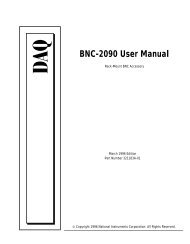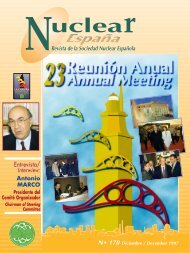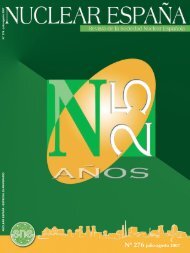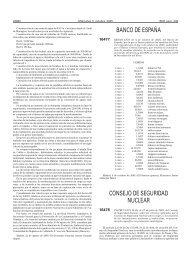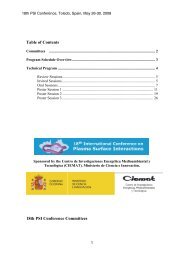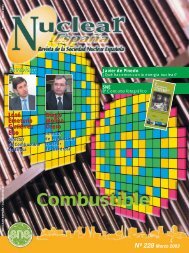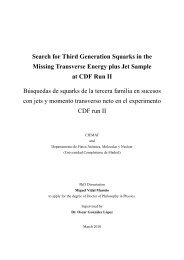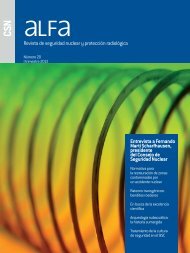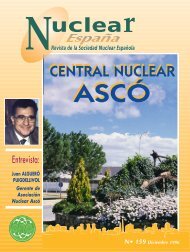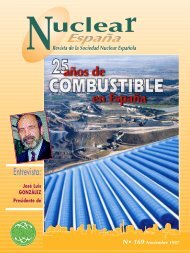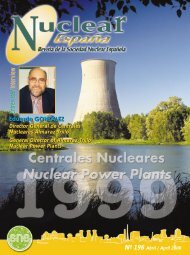You also want an ePaper? Increase the reach of your titles
YUMPU automatically turns print PDFs into web optimized ePapers that Google loves.
prior to the 10th refueling outage, which took placebetween 25 February and 2 April and was completedwithout incident in 36 days (the estimated duration was 40days). Thus it was the shortest refueling outage of allthose carried out in this Unit.Another five shutdowns were registered during the year,four of them automatic reactor shutdowns and oneperformed to repair the condenser.At year’s end, the Unit was operating at full power, with atotal of 193 days (at 31 January 1996) on line withoutinterruption since the last connection to the grid.Gross electricity production was 6,843,250 MWh, with aload factor of 84% and an operating factor of 88%.Accumulated production from the beginning is 87,168,570MWh.UNIT IIThis Unit stayed on line uninterruptedly from 27 June1994 to 21 July 1995, which amounts to a total of 389days, the second longest period achieved (the first onewas 468 days long). The most outstanding activity duringthe year was the scheduled outage to perform the ninthrefueling, which was carried out without incident between26 August and 25 September in a total of 30 days, whichmeans that it was the shortest of those performed in thePlant.In addition to the refueling, three other shutdowns wereregistered: two automatic reactor shutdowns and one formaking a repair in the high voltage yard.At year’s end, the Unit was operating at full power, with atotal of 129 days (at 31 January 1996) on line withoutinterruption since the last connection to the grid.Gross electricity production was 7,054,680 MWh, with aload factor of 86.59% and an operating factor of 91.11%.Accumulated production from the beginning is 84,009,180MWh.10th UNIT I REFUELINGIn addition to the normal refueling activities, otheroperations were performed during the outage, includingthe following:• Steam generator inspection. After induced currentinspection, the number of plugged tubes was 52, 37 and50 in SGs 1, 2 and 3, respectively.• Topometry of steam generator legs and supports, andmarking of the containment wall opening for removalintroductionof same and perforation of the appropriatewalls for feedthrough of piping. This activity is part of thesteam generator replacement project to be performed inthe next refueling outage scheduled for 1996.• As part of preventive maintenance of the reactorcooling pumps, the motor of RCP-2 was replaced by thestandby, and the closure seals of RCP-1 and RCP-2 wereinspected. In RCP-3, only the cooldown unit wasinspected.• All containment building penetrations were inspected.• The most important programmed work in the turbosetwas inspection and repair of the high pressure turbinerotor and replacement of one of the low pressure turbineswith the standby.During turboset maintenance, Siemens collected thedata required for incorporation of the newly designedturbines to be implemented in the next refueling outage.• Other work worth mentioning was replacement of themain condenser tube bundles. The basic purpose of thisreplacement (copper by titanium tubes) and replacementof condensate pump bearings is to eliminate copper fromthe secondary circuit and protect the steam generators.Also, by eliminating the copper, the feedwater pH can beincreased, which will help to mitigate the secondary circuiterosion-corrosion phenomenon.• Replacement of main transformer phase “T” with thestandby.• A capacity test was performed on 125 V batteries ofboth trains with satisfactory results.• Several design modifications were made to optimizeplant operation, as well as tailor it to the latesttechnological advances in the sector.9th UNIT II REFUELINGIn addition to the normal refueling activities, otheroperations were performed during the outage, includingthe following:• Steam generator inspection. After induced currentinspection, the number of plugged tubes was 145, 83 and67 in SGs 1, 2 and 3, respectively.• The same as in Unit I, several jobs were performed,including topometry in the containment building as aprior step to the steam generator replacement to beperformed during the next refueling outage scheduledfor 1997.implantar en la próxima parada de recarga.• Otro de los trabajos a considerarfue el de sustitución de haces tubularesdel condensador principal.El principal objetivo a alcanzar coneste cambio (tubos de cobre por titanio)y con el del cambio de cojinetesen bombas de condensado es eliminarel cobre del circuito secundario yproteger los generadores de vapor.Asimismo, eliminado el cobre, se puedeelevar el pH del agua de alimentación,con lo que se mitigará el fenómenoerosión-corrosión en el circuitosecundario.• Sustitución de la fase “T” del transformadorprincipal por la de reserva.• Se realizó, con resultado satisfactorio,prueba de capacidad a bateríasde 125 V de ambos trenes.• Incorporación de diversas modificacionesde diseño, que permiten optimizarel funcionamiento de la instalación,así como adecuarla a losúltimos avances tecnológicos del sector.9ª RECARGA UNIDAD IIDurante la parada, además de las actividadespropias de recarga de combustible,se llevaron a cabo, entreotras, las siguientes operaciones:• Inspección de los generadores devapor. Los tubos taponados tras lainspección por corrientes inducidasfueron 145, 83 y 67 tubos en los GV-1, 2, y 3, respectivamente.• A igual que en la Unidad I se realizarondiversos trabajos, entre otros,los de topometría, en el recinto decontención, como paso previo a lasustitución de generadores de vapora efectuar durante la próxima paradade recarga, prevista para 1997.• Sustitución de los haces tubularesdel condensador principal.• En el turbogrupo se realizó la revisióne inspección de las válvulas decontrol y parada de turbina.• En cuanto a las bombas de refrigeracióndel circuito primario se extrajoel motor de la RCP-1, sustituyéndosepor el de reserva y se inspeccionaronlos sellos de las RCP-1 y RCP-2.• Se llevó a cabo la inspección delas penetraciones del recinto de contención.• Al igual que en la Unidad I se ejecutarondiversas modificaciones dediseño, que permiten optimizar el funcionamientode la instalación, así comoadecuarla a los últimos avancestecnológicos del sector.INCIDENCIAS 1995. UNIDAD I- El 2 de febrero esta Unidad sufrióuna parada automática de reactor, porparada automática de turbina, debidoa la actuación de las protecciones delalternador principal, a consecuenciaFACTORES DE DISPONIBILIDADAVAILABILITY FACTORF. Indisponibilidadno programada 2,94%Unsheduled UnavailabilityfactorF. Indisponibilidadno programada 1,12%Unsheduled UnavailabilityfactorUNIDAD I / UNIT IF. Indisponibilidadprogramada 10,63%Scheduled UnavailabilityfactorF. DISPONIBILIDAD / AVAILABILITY F.86,43%UNIDAD II / UNIT IIF. Indisponibilidadprogramada 8,65%Scheduled UnavailabilityfactorF. DISPONIBILIDAD / AVAILABILITY F.90,23%de la actuación de la protección propiadel transformador principal poravería de un transformador del parquede 400 Kv.- El 1 de abril, cuando se encontrabanen curso las pruebas nuclearesal 0% de potencia, previas al acoplamientotras la finalización de las actividadesprogramadas para la paradade recarga, se originó parada automáticade reactor por parada automáticade turbina, debido a la actuacióninvoluntaria del PS-446A.Identificada la causa, a las 9,40 horasse volvió a hacer crítico el reactor,reanudándose las pruebas nucleares.- A las 11,33 horas del día 3 deabril, durante el transcurso de la subidaescalonada de carga, tras la paradade recarga se produjo paradade reactor, por parada automática deturbina, como consecuencia del bajovacío en el condensador. Detectadala anomalía, el reactor se hizo nuevamentecrítico a las 14,50 horas de estemismo día y se acopló la Unidad ala red a las 23,09 horas.- El 22 de abril, a las 3,55 horas,ante la detección de una entrada deagua del embalse de refrigeración enel condensador principal, que originóla alteración de los parámetros químicosdel circuito secundario, se inicióuna bajada de carga de la Unidad,desacoplándose la misma de la red alas 7,50 horas.Investigada la causa de dicha entradade agua y efectuadas las comprobacionescorrespondientes, se inicióel calentamiento de la Unidad, haciéndosecrítico el reactor a las 4,25



